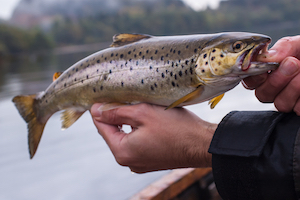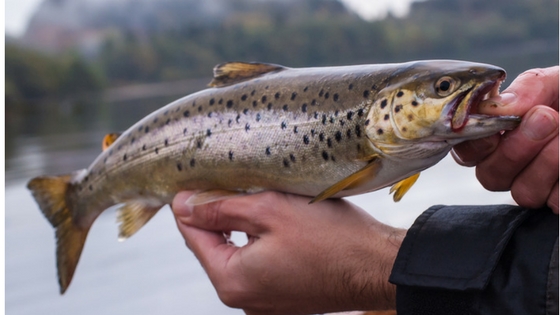Brown Trout Lake Fishing

 Where you’ll find big Brown Trout
Where you’ll find big Brown Trout
Brown Trout are not fond of direct sunlight. They avoid it preferring to be in cover waiting for prey to swim by while the sun is out.
In the summer, when it’s hot, they’ll migrate from the shallow water to deep water in order to stay below the thermocline and stay cool.
At this time, they’ll school together and be close to the bottom even if there’s little cover.
In the spring and early fall, your best bet for success is to cast into the shallows.
Fly fishing is the best and most enjoyable type of fishing for the spring. Dry flies will cause little noise and won’t scare away the fish nearly as much as casting a lure into the water.
How to fish lakes for Brown Trout
Cast your fly within a few feet of where you expect the Brown Trout to be located.
With bait casting, aim your lure about 10 to 15 feet away from where you expect the Brown Trout to be and reel it in so it’s close to their position, within about 4 feet.
- For night fishing, try using a bass plug.
What not to do:
Trolling won’t catch Brown Trout
One of the reasons for this is that the techniques used for Lake Trout and Salmon don’t work on Brown Trout.
Brown Trout hate noise and can be scared away when using trolling methods which is the most common method for catching fish not in the great lakes.
In warm weather when you’re needing to get below the thermocline is the only time we suggest trolling.
Brown Trout Fishing Tips
- Use a light monofilament line no more than 8 pound test for extra sensitivity.
- If you’re experienced, try going with 6 pounds but make sure to loosen the drag properly to prevent the line from snapping due to a solid strike and over actively setting the hook.
- If you’re going to fish from a boat, head out to your fishing spot on low power and use an electric motor to move your boat slowly and silently.
- If you don’t have an electric motor, let the line out several hundred feet where the noise of the bait will be lessened.
However, fishing the shores and the mouths of rivers is the easiest and the best approach in the spring as they come to the shallows to feed.
Anglers may cast for Great Lakes big browns in both the spring and fall, and any other tributary streams that carry spawning browns from smaller lakes and ponds.
In the spring wade the shoreline and cast small silver spoons with light spinning tackle at the mouth of the feeder streams where the smelt and alewives run.
Spring fishing is even better after a rain when the water is discolored and the Brown Trout move into shallow water (3 feet deep or shallower) to feed. The fish will roll in the cold water, like spawning carp, but will rarely jump out of the water.
Once a brown takes a lure, it will swim for deep water.
- Use a spinning reel with at least 300 yards of line.
The spring big brown trout range from an average of 10 to over 30 pounds. and need extra line to run or they will break the line.
In spring and fall when the browns feed throughout the day, try trolling without a down rigger in clear water at 10 or 15 feet deep.
The Great Lakes are a great place to catch Brown Trout in North America, if not in the world. Although many in Scotland, England and Germany would like to disagree with this unfounded claim.
The extensive stocking in the seventies is a big reason for the large stocks of Brown Trout. And, as the Great Lakes have so many large sport fish, the Brown Trout have more or less been left alone.


